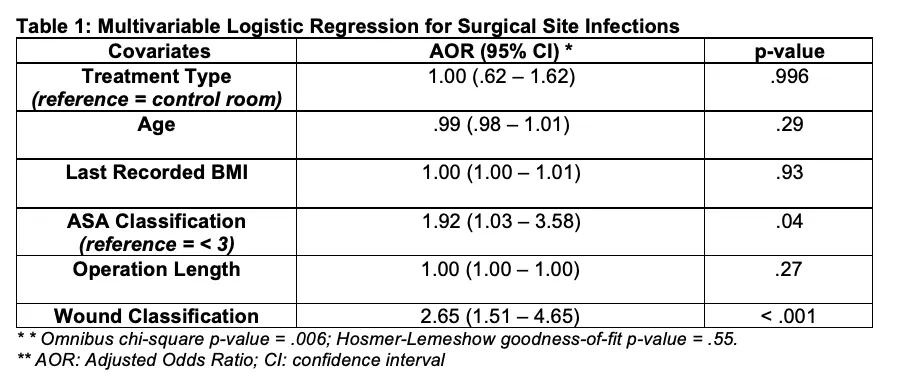Shining the Light on Surgical Site Infection Reduction: Is the answer in the lights itself?
Author(s):
Wayne Bauerle; Anthony Allsbrook; Alyssa Green; Nakosi Stewart; Jill Stoltzfus; Cliff Yahnke; William Burfeind
Background:
Surgical site infections (SSIs) are a significant contributor to morbidity and mortality. 405nm Visible Light Disinfection (VLD) has been shown to reduce bacterial burden in operating rooms; however, the effect on SSI rates has been poorly studied.
Hypothesis:
The use of VLD will reduce SSI rates at a single academic medical center.
Methods:
A prospective cohort study was performed by comparing 3 operating rooms fitted with VLD and 3 operating rooms fitted with standard lights. Bacterial loads within the 6 ORs of interest were obtained before and after initiation of VLD. Patients were randomly assigned to rooms and specialties including orthopedic, neurosurgery, general, cardiac, vascular, and thoracic surgery. SSI rates were tracked from July 2019 to June 2022. The primary outcome of interest was SSI rate. The secondary outcome of interest was room bacterial load.
Results:
Rooms fitted with VLD experienced a 66% reduction in bacterial load compared with baseline. 5,036 patients had surgery in VLD rooms and 6,345 in control rooms. Age, sex, and BMI were similar between groups while there were differences in ASA, operation length, and wound class. There were no overall significant differences in observed SSI rates between control and VLD rooms (0.8% vs 0.8%, p=0.71). There were no significant differences in SSI rates by specialty. After adjusting for covariates, VLD was not independently associated with SSI rate (Table 1).

Conclusions:
The VLD effectively reduced overall operating room bacterial burden, however, this did not result in a significant reduction in SSI rates. The cause of SSIs is multifactorial and may be influenced more by patient and technical factors than overall operating room bacterial burden.
